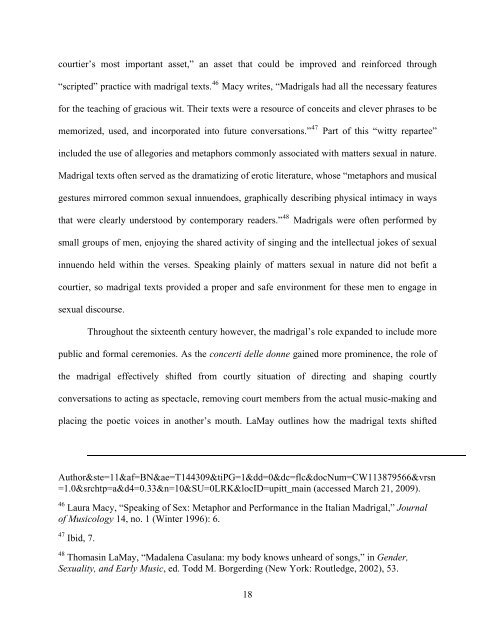Download - D-Scholarship@Pitt - University of Pittsburgh
Download - D-Scholarship@Pitt - University of Pittsburgh
Download - D-Scholarship@Pitt - University of Pittsburgh
Create successful ePaper yourself
Turn your PDF publications into a flip-book with our unique Google optimized e-Paper software.
courtier’s most important asset,” an asset that could be improved and reinforced through<br />
“scripted” practice with madrigal texts. 46 Macy writes, “Madrigals had all the necessary features<br />
for the teaching <strong>of</strong> gracious wit. Their texts were a resource <strong>of</strong> conceits and clever phrases to be<br />
memorized, used, and incorporated into future conversations.” 47 Part <strong>of</strong> this “witty repartee”<br />
included the use <strong>of</strong> allegories and metaphors commonly associated with matters sexual in nature.<br />
Madrigal texts <strong>of</strong>ten served as the dramatizing <strong>of</strong> erotic literature, whose “metaphors and musical<br />
gestures mirrored common sexual innuendoes, graphically describing physical intimacy in ways<br />
that were clearly understood by contemporary readers.” 48 Madrigals were <strong>of</strong>ten performed by<br />
small groups <strong>of</strong> men, enjoying the shared activity <strong>of</strong> singing and the intellectual jokes <strong>of</strong> sexual<br />
innuendo held within the verses. Speaking plainly <strong>of</strong> matters sexual in nature did not befit a<br />
courtier, so madrigal texts provided a proper and safe environment for these men to engage in<br />
sexual discourse.<br />
Throughout the sixteenth century however, the madrigal’s role expanded to include more<br />
public and formal ceremonies. As the concerti delle donne gained more prominence, the role <strong>of</strong><br />
the madrigal effectively shifted from courtly situation <strong>of</strong> directing and shaping courtly<br />
conversations to acting as spectacle, removing court members from the actual music-making and<br />
placing the poetic voices in another’s mouth. LaMay outlines how the madrigal texts shifted<br />
Author&ste=11&af=BN&ae=T144309&tiPG=1&dd=0&dc=flc&docNum=CW113879566&vrsn<br />
=1.0&srchtp=a&d4=0.33&n=10&SU=0LRK&locID=upitt_main (accessed March 21, 2009).<br />
46 Laura Macy, “Speaking <strong>of</strong> Sex: Metaphor and Performance in the Italian Madrigal,” Journal<br />
<strong>of</strong> Musicology 14, no. 1 (Winter 1996): 6.<br />
47 Ibid, 7.<br />
48 Thomasin LaMay, “Madalena Casulana: my body knows unheard <strong>of</strong> songs,” in Gender,<br />
Sexuality, and Early Music, ed. Todd M. Borgerding (New York: Routledge, 2002), 53.<br />
18















